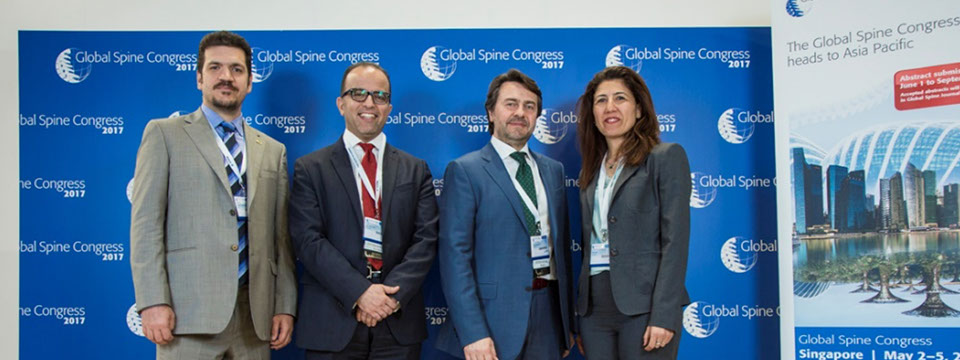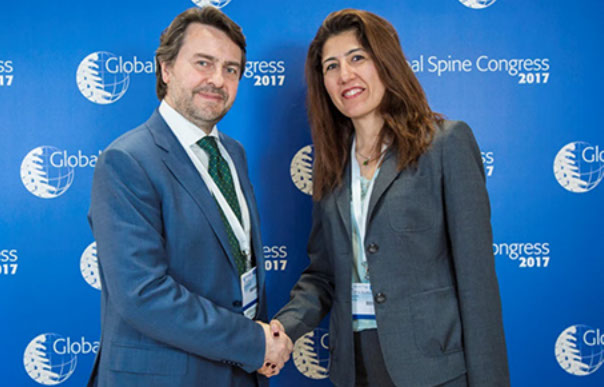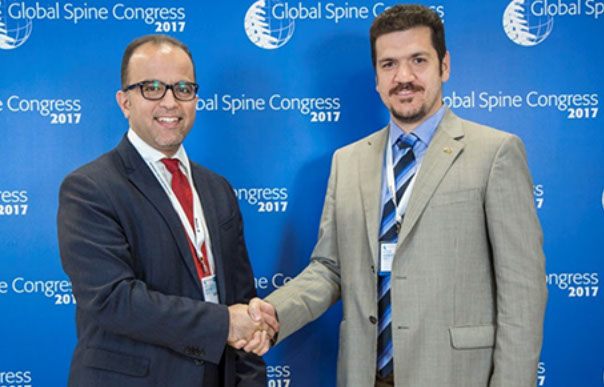Inspiring Leadership
Michael FehlingsHighlights
Pushing the boundaries – leading the way in spine tumor research
AOSpine Sacral Classification System
Launch of AOSpine Fellows Alumni Group
AOSpine Mentorship Education – learn from the best
Global Spine Journal – special focus issues, mobile-friendly, and more…
Meet the winners of the European and Middle Eastern Young Researcher Awards 2017
AOSpine Ambassadors program launch

Meet the winners of the European and Middle Eastern Young Researcher Awards 2017
In order to encourage young researchers in the field of spinal care, and to support their work, AOSpine Europe and AOSpine Middle East send out annually a call for papers to their communities. Also in 2017, both regions received a good response rate with high quality participations, out of which the two best ones were chosen. Next to a financial contribution for their future research projects, AOSpine was pleased to invite both winners to the Global Spine Congress in Milano.
Europe
In the reviewing and scoring process of the 25 applications for the European YRA 2017, coming from 11 different countries, one paper stood out. The first place went to Turkey, more specifically to Derya Burcu Hazer from the Mugla Sıtkı Koçman University with her research on "Antimicrobial Effect of Polymer-Based Silver Nanoparticle Coated Pedicle Screws: Experimental Research on Biofilm Inhibition in Rabbits". In the study, the authors looked at a novel spine implant model that was designed to better understand the antimicrobial effect of a modified Titanium (Ti) pedicle screws with MRSA in multiple surgical sites in the lumbar spine of a rabbit. Twenty two New Zealand White rabbits were divided into group 1: infected unmodified Ti screw group (n=10), group 2: infected PP-g-PEG-Ag covered Ti screw group (n=10), and two rabbits as control-sterile group. The bacterial colony count for modified-Ti screw group was lower compared to unmodified Ti screw (17,2 vs 200 x 103 CFU/mL, p=0,029) with less biofilm formation. Ag-NPs were detected on the screw surface on 21st day postoperatively. This novel experimental design of implantation in rabbits is easy to apply and resembles human stabilization technique. Modified Ti screws were shown to have antimicrobial effect with especially inhibiting the biofilm formation. This anchored Ag NPs shows that it is resistant to tapping forces. AOSpine thanks Dr Hazer for her valid contribution.

AOSEU Board Chairman Giuseppe Barbagallo congratulating the EU YRA 2017 winner Derya Burcu Hazer at the GSC 2017, Milano, Italy
Middle East
Following our call for applications, AOSME received 15 papers from 10 different countries all over the Middle East, of which 11 fulfilled all requirements. Out of these, a committee consisting of the AOSME Councils officers for Research have reviewed the papers, scored them by indicators such as citations of the paper, or the impact of the journal the participating paper had been published in. The first ranked paper came from Iran. 32-years old Amir Azarhomayoun from Tehran had won with his excellent article on "Sequestrectomy Versus Conventional Microdiscectomy for the Treatment of a Lumbar Disc Herniation: A Systematic Review".

AOSME Board Chairman Abdulaziz Al-Mutair congratulating the ME YRA 2017 winner Amir Azarhomayoun at the GSC 2017, Milano, Italy
The 2017 Young Researcher Award showed again the outstanding role of Iran concerning research in the region, but also the increasing quality from other parts of the Middle East, such as Lebanon, Palestine, and many others, which is a special pleasure to us. Dr Azarhomayoun summarizes his paper as follows: Open surgery for LDH can be performed by sequestrectomy (removal of disc fragments) or conventional discectomy (removal of disc fragments and disc). Sequestrectomy might be associated with a higher risk of recurrence but less low back pain (LBP) after surgery.The aim of this study was to compare the effects of sequestrectomy versus conventional microdiscectomy for lumbar disc herniation (LDH). We searched MEDLINE and EMBASE from 1980 to November 2014. We selected randomized controlled trials (RCTs) and nonrandomized prospective studies of conventional discectomy versus sequestrectomy for adult patients with LDH that evaluated the following primary outcomes: radicular pain or LBP as measured by a visual analog scale, or neurological deficits of the lower extremity. We also evaluated the following secondary outcomes: complications of surgery, reherniation rate, duration of hospital stay, postoperative analgesic use, and health-related quality-of-life measures. Two authors independently reviewed citations and articles for inclusion. We assessed the risk of bias, synthesized data, and the level evidence using standard methodological procedures as recommended by the Cochrane Back Review Group. We identified 5 studies (746 participants) of sequestrectomy versus microdiscectomy. One study was RCT and the other 4 were nonrandomized prospective comparisons; all studies were assessed as being at a high risk of bias. There were no significant differences for leg pain, LBP, functional outcomes,complications, and hospital stay or recurrence rate for 2 years(level of evidence: Low). Sequestrectomy was associated with less analgesic consumption versus discectomy (level of evidence: Very low). In conclusion, Sequestrectomy and standard microdiscectomy were associated with similar effects on pain after surgery,recurrence rate, functional outcome, and complications; more evidence is needed to determine whether sequestrectomy is associated with less postoperative analgesic consumption.
Please join us in congratulation both winners for their achievement.
Newsletter 12 August 2017
Highlights
Inspiring Leadership –
Michael Fehlings
Pushing the boundaries – leading the way in spine tumor research
AOSpine Sacral Classification System
Launch of AOSpine Fellows Alumni Group
AOSpine Mentorship Education – learn from the best
Global Spine Journal – special focus issues, mobile-friendly, and more…